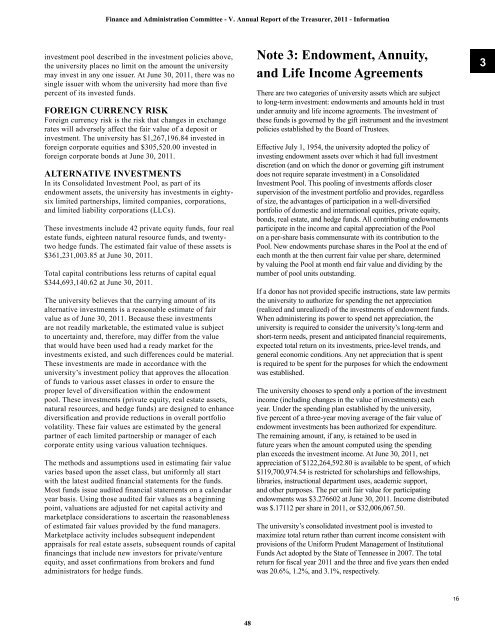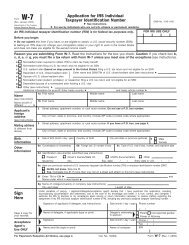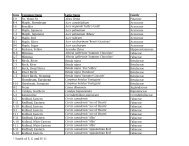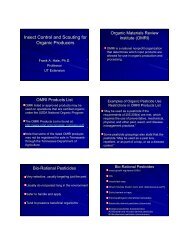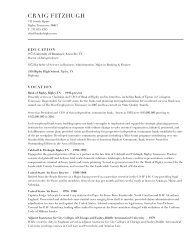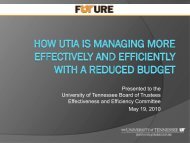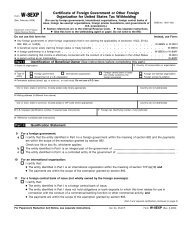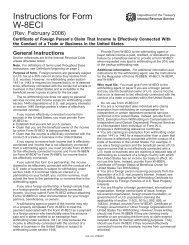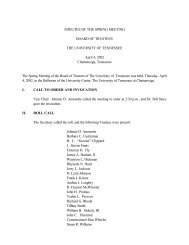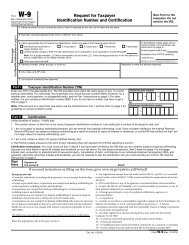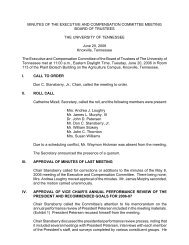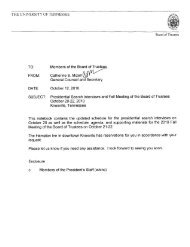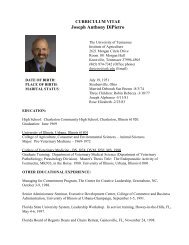Finance and Administration - Board of Trustees - The University of ...
Finance and Administration - Board of Trustees - The University of ...
Finance and Administration - Board of Trustees - The University of ...
You also want an ePaper? Increase the reach of your titles
YUMPU automatically turns print PDFs into web optimized ePapers that Google loves.
<strong>Finance</strong> <strong>and</strong> <strong>Administration</strong> Committee - V. Annual Report <strong>of</strong> the Treasurer, 2011 - Informationinvestment pool described in the investment policies above,the university places no limit on the amount the universitymay invest in any one issuer. At June 30, 2011, there was nosingle issuer with whom the university had more than fivepercent <strong>of</strong> its invested funds.FOREIGN CURRENCY RISKForeign currency risk is the risk that changes in exchangerates will adversely affect the fair value <strong>of</strong> a deposit orinvestment. <strong>The</strong> university has $1,267,196.84 invested inforeign corporate equities <strong>and</strong> $305,520.00 invested inforeign corporate bonds at June 30, 2011.ALTERNATIVE INVESTMENTSIn its Consolidated Investment Pool, as part <strong>of</strong> itsendowment assets, the university has investments in eightysixlimited partnerships, limited companies, corporations,<strong>and</strong> limited liability corporations (LLCs).<strong>The</strong>se investments include 42 private equity funds, four realestate funds, eighteen natural resource funds, <strong>and</strong> twentytwohedge funds. <strong>The</strong> estimated fair value <strong>of</strong> these assets is$361,231,003.85 at June 30, 2011.Total capital contributions less returns <strong>of</strong> capital equal$344,693,140.62 at June 30, 2011.<strong>The</strong> university believes that the carrying amount <strong>of</strong> itsalternative investments is a reasonable estimate <strong>of</strong> fairvalue as <strong>of</strong> June 30, 2011. Because these investmentsare not readily marketable, the estimated value is subjectto uncertainty <strong>and</strong>, therefore, may differ from the valuethat would have been used had a ready market for theinvestments existed, <strong>and</strong> such differences could be material.<strong>The</strong>se investments are made in accordance with theuniversity’s investment policy that approves the allocation<strong>of</strong> funds to various asset classes in order to ensure theproper level <strong>of</strong> diversification within the endowmentpool. <strong>The</strong>se investments (private equity, real estate assets,natural resources, <strong>and</strong> hedge funds) are designed to enhancediversification <strong>and</strong> provide reductions in overall portfoliovolatility. <strong>The</strong>se fair values are estimated by the generalpartner <strong>of</strong> each limited partnership or manager <strong>of</strong> eachcorporate entity using various valuation techniques.<strong>The</strong> methods <strong>and</strong> assumptions used in estimating fair valuevaries based upon the asset class, but uniformly all startwith the latest audited financial statements for the funds.Most funds issue audited financial statements on a calendaryear basis. Using those audited fair values as a beginningpoint, valuations are adjusted for net capital activity <strong>and</strong>marketplace considerations to ascertain the reasonableness<strong>of</strong> estimated fair values provided by the fund managers.Marketplace activity includes subsequent independentappraisals for real estate assets, subsequent rounds <strong>of</strong> capitalfinancings that include new investors for private/ventureequity, <strong>and</strong> asset confirmations from brokers <strong>and</strong> fundadministrators for hedge funds.Note 3: Endowment, Annuity,<strong>and</strong> Life Income Agreements<strong>The</strong>re are two categories <strong>of</strong> university assets which are subjectto long-term investment: endowments <strong>and</strong> amounts held in trustunder annuity <strong>and</strong> life income agreements. <strong>The</strong> investment <strong>of</strong>these funds is governed by the gift instrument <strong>and</strong> the investmentpolicies established by the <strong>Board</strong> <strong>of</strong> <strong>Trustees</strong>.Effective July 1, 1954, the university adopted the policy <strong>of</strong>investing endowment assets over which it had full investmentdiscretion (<strong>and</strong> on which the donor or governing gift instrumentdoes not require separate investment) in a ConsolidatedInvestment Pool. This pooling <strong>of</strong> investments affords closersupervision <strong>of</strong> the investment portfolio <strong>and</strong> provides, regardless<strong>of</strong> size, the advantages <strong>of</strong> participation in a well-diversifiedportfolio <strong>of</strong> domestic <strong>and</strong> international equities, private equity,bonds, real estate, <strong>and</strong> hedge funds. All contributing endowmentsparticipate in the income <strong>and</strong> capital appreciation <strong>of</strong> the Poolon a per-share basis commensurate with its contribution to thePool. New endowments purchase shares in the Pool at the end <strong>of</strong>each month at the then current fair value per share, determinedby valuing the Pool at month end fair value <strong>and</strong> dividing by thenumber <strong>of</strong> pool units outst<strong>and</strong>ing.If a donor has not provided specific instructions, state law permitsthe university to authorize for spending the net appreciation(realized <strong>and</strong> unrealized) <strong>of</strong> the investments <strong>of</strong> endowment funds.When administering its power to spend net appreciation, theuniversity is required to consider the university’s long-term <strong>and</strong>short-term needs, present <strong>and</strong> anticipated financial requirements,expected total return on its investments, price-level trends, <strong>and</strong>general economic conditions. Any net appreciation that is spentis required to be spent for the purposes for which the endowmentwas established.<strong>The</strong> university chooses to spend only a portion <strong>of</strong> the investmentincome (including changes in the value <strong>of</strong> investments) eachyear. Under the spending plan established by the university,five percent <strong>of</strong> a three-year moving average <strong>of</strong> the fair value <strong>of</strong>endowment investments has been authorized for expenditure.<strong>The</strong> remaining amount, if any, is retained to be used infuture years when the amount computed using the spendingplan exceeds the investment income. At June 30, 2011, netappreciation <strong>of</strong> $122,264,592.80 is available to be spent, <strong>of</strong> which$119,700,974.54 is restricted for scholarships <strong>and</strong> fellowships,libraries, instructional department uses, academic support,<strong>and</strong> other purposes. <strong>The</strong> per unit fair value for participatingendowments was $3.276602 at June 30, 2011. Income distributedwas $.17112 per share in 2011, or $32,006,067.50.<strong>The</strong> university’s consolidated investment pool is invested tomaximize total return rather than current income consistent withprovisions <strong>of</strong> the Uniform Prudent Management <strong>of</strong> InstitutionalFunds Act adopted by the State <strong>of</strong> Tennessee in 2007. <strong>The</strong> totalreturn for fiscal year 2011 <strong>and</strong> the three <strong>and</strong> five years then endedwas 20.6%, 1.2%, <strong>and</strong> 3.1%, respectively.31648


